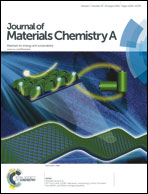Hierarchical architectures of monodisperse porous Cu microspheres: synthesis, growth mechanism, high-efficiency and recyclable catalytic performance†
Abstract
Novel hierarchical architectures of porous copper (Cu) microspheres assembled with nanoparticles have been successfully synthesized by ingeniously selecting the precursor and complexant through a facile wet chemical reduction method. The resultant porous Cu microspheres have a size distribution of 700 ± 50 nm and have excellent monodispersity. The synergistic effect between the precursor of slightly soluble copper hydroxide and the complexants of polyacrylic acid and ethanol amine exactly induces the generation of unique porous hierarchical architectures. The obtained porous Cu microspheres were applied to reduce and degrade different organic dyes with high concentrations (4-nitrophenol, methylene blue, and rhodamine B) in the presence of NaBH4. Compared with solid Cu particles that have the same size, these porous Cu microspheres exhibit more excellent catalytic activity due to their hierarchical structures. Moreover, the catalyst with universal applicability could be easily separated from the catalytic system and sustainedly possess high stability in recycled reactions.


 Please wait while we load your content...
Please wait while we load your content...